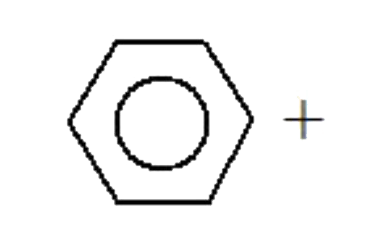Heating of [CH3CH2CH2CH(CH3)N+(CH3)3OH− gives the major product :
CH2=CH2
CH3CH2CH2CH=CH2
CH3CH2CH=CHCH3
CH2=CHCH2CH=CH2
The correct Answer is:B
To solve the problem of determining the major product formed by heating the compound (CH3CH2CH2CH(CH3)N+(CH3)3OH−), we can follow these steps:
Step 1: Identify the Compound
The given compound is a quaternary ammonium hydroxide. It has the structure:
CH3CH2CH2CH(CH3)N+(CH3)3OH−
Step 2: Understand the Reaction
When quaternary ammonium hydroxides are heated, they undergo a reaction known as the Hofmann elimination. This reaction typically results in the formation of an alkene.
Step 3: Analyze the Structure
In the compound, the nitrogen atom is positively charged and is bonded to four alkyl groups. The alpha carbon is the one directly attached to the nitrogen, and the beta carbons are those adjacent to the alpha carbon.
Step 4: Identify Beta Hydrogens
From the structure, we can identify the beta hydrogens:
- The alpha carbon (attached to nitrogen) has two beta carbons, each with one hydrogen atom that can be eliminated.
Step 5: Apply Hofmann's Rule
According to Hofmann's rule, the less substituted alkene will be the major product. In this case, the elimination can occur from either of the beta positions:
1. Removing a hydrogen from the first beta carbon (leading to a less substituted alkene).
2. Removing a hydrogen from the second beta carbon (leading to a more substituted alkene).
Step 6: Determine the Major Product
The less substituted alkene will be formed by removing a hydrogen from the first beta carbon. The structure of the resulting alkene will be:
CH3CH2CH2CH=CH2
This is the major product of the reaction.
Step 7: Conclusion
The major product formed upon heating the given quaternary ammonium hydroxide is:
CH3CH2CH2CH=CH2
Final Answer
The correct option corresponding to the major product is option number two.
---
The given compound is a quaternary ammonium hydroxide. It has the structure:
CH3CH2CH2CH(CH3)N+(CH3)3OH−
When quaternary ammonium hydroxides are heated, they undergo a reaction known as the Hofmann elimination. This reaction typically results in the formation of an alkene.
In the compound, the nitrogen atom is positively charged and is bonded to four alkyl groups. The alpha carbon is the one directly attached to the nitrogen, and the beta carbons are those adjacent to the alpha carbon.
From the structure, we can identify the beta hydrogens:
- The alpha carbon (attached to nitrogen) has two beta carbons, each with one hydrogen atom that can be eliminated.
According to Hofmann's rule, the less substituted alkene will be the major product. In this case, the elimination can occur from either of the beta positions:
1. Removing a hydrogen from the first beta carbon (leading to a less substituted alkene).
2. Removing a hydrogen from the second beta carbon (leading to a more substituted alkene).
The less substituted alkene will be formed by removing a hydrogen from the first beta carbon. The structure of the resulting alkene will be:
CH3CH2CH2CH=CH2
This is the major product of the reaction.
The major product formed upon heating the given quaternary ammonium hydroxide is:
CH3CH2CH2CH=CH2
The correct option corresponding to the major product is option number two.
Topper's Solved these Questions
- AMINESBOOK - VMC MODULES ENGLISHCHAPTER - AMINESEXERCISE - EFFICIENT
49 Videos
- AMINESBOOK - VMC MODULES ENGLISHCHAPTER - AMINESEXERCISE - IMPECCABLE
48 Videos
- AMINESBOOK - VMC MODULES ENGLISHCHAPTER - AMINESEXERCISE - IN CHAPTER EXERCISE H
10 Videos
- ALDEHYDES,KETONES & CARBOXYLIC ACIDS BOOK - VMC MODULES ENGLISHCHAPTER - ALDEHYDES,KETONES & CARBOXYLIC ACIDS EXERCISE - IN-CHAPTER EXERCISE-M
10 Videos
- ATOMIC STRUCTUREBOOK - VMC MODULES ENGLISHCHAPTER - ATOMIC STRUCTUREEXERCISE - JEE Advanced (Archive )
67 Videos
Similar Questions
Knowledge Check
The reaction :
CH3CH2l+KOH(aq)→CH3CH2OH+Kl
is classified asAelectrophilic substitutionBnucleophilic substitutionCeliminationDadditionCH3CH2CH(OH)CH(CH3)2+CH3COClBase−−→CH3CH2CH(OCOCH3)CH(CH3)2+HCl
in the above reaction, if the reactant alcohol is pure R-isomers, the product wouldAhave configuration inverted at the chiral atomBbe a racemic mixtureChave the same configuration at the chiral atomDbe optically inactive
Write the IUPAC name of
CH3−CH2−CH2−CH(OH)−CH3
View SolutionWrite the IUPAC name of
CH3−CH2−CH2−CH(OH)−CH3
View SolutionCH3−C≡C−CH3+HBr→ Major product is :
View SolutionCH3−CH2−CH2−CH3+Cl2hv−−→ Major product :
View Solution(CH3)3C−OCH3 on reaction with HI gives (CH3)3C−IandCH3−OH as the main products and not (CH3)3C−OHandCH3−I. Explain.
View SolutionAn alcohol on oxidation is found to give CH3COOH and CH3CH(OH)CH2CH2CH3 The structure of the alcohol is :
View Solution

 +
+